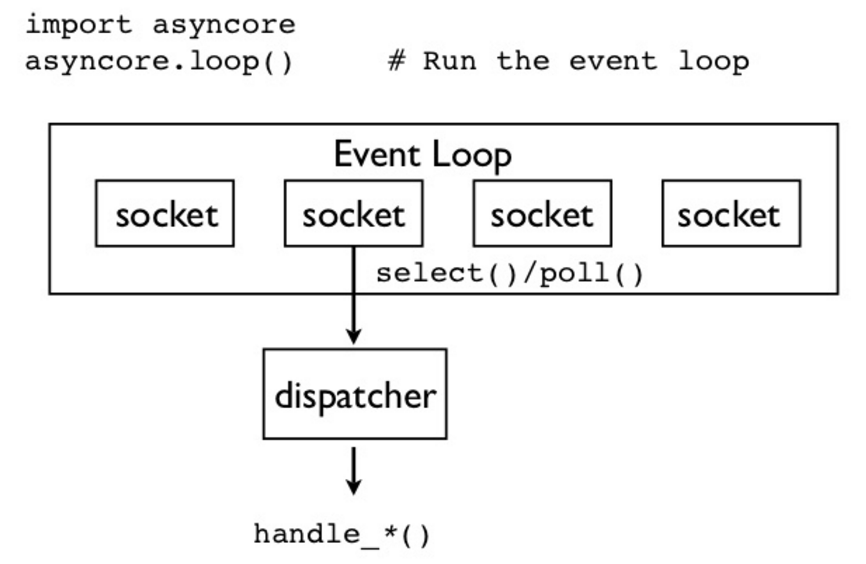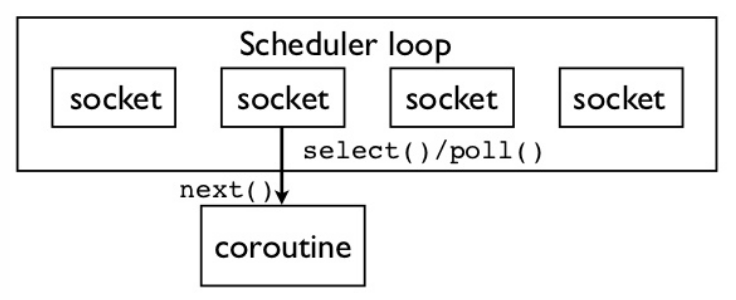Event Loop
实现并发,可以采用多线程/多进程方式,但是多线程/多进程有可能引起其它问题(如:数据同步,竞争条件,上下文切换的开销等)。 那么除了多线程/进程外,还有哪些实现并发的方式?--event loop(即利用IO多路复用机制)。
首先,我们需要使用一个系统调用去轮询文件描述符(stdin) 查看是否有输入,根据不同的操作系统,有不同的系统调用如:poll, select, kqueue。在Python3.4中,selectors模块封装了这些系统调用的方法。
有了轮询,event loop 的实现就很简单了,在每次循环中,我们都会查看是否有可读事件,如果有便读入并处理。
例子:
import selectors
import sys
from time import time
from fib import timed_fib
def process_input(stream):
text = stream.readline()
n = int(text.strip())
print('fib({}) = {}'.format(n, timed_fib(n)))
def print_hello():
print("{} - Hello world!".format(int(time())))
def main():
selector = selectors.DefaultSelector()
# Register the selector to poll for "read" readiness on stdin
selector.register(sys.stdin, selectors.EVENT_READ)
last_hello = 0 # Setting to 0 means the timer will start right away
while True:
# Wait at most 100 milliseconds for input to be available
for event, mask in selector.select(0.1):
process_input(event.fileobj)
if time() - last_hello > 3:
last_hello = time()
print_hello()
if __name__ == '__main__':
main()
输出为
$ python3.4 hello_eventloop.py
1412376429 - Hello world!
1412376432 - Hello world!
1412376435 - Hello world!
37
Executing fib took 9.7 seconds.
fib(37) = 24157817
1412376447 - Hello world!
1412376450 - Hello world!
如上可见,由于是单线程,”读取并处理输入”事件阻塞了”打印Hello World”事件。
Event Loop with Callbacks
对于每一个事件类型,都注册一个回调函数。

例子:
from bisect import insort
from collections import namedtuple
from fib import timed_fib
from time import time
import selectors
import sys
Timer = namedtuple('Timer', ['timestamp', 'handler'])
class EventLoop(object):
"""
Implements a callback based single-threaded event loop as a simple
demonstration.
"""
def __init__(self, *tasks):
self._running = False
self._stdin_handlers = []
self._timers = []
self._selector = selectors.DefaultSelector()
self._selector.register(sys.stdin, selectors.EVENT_READ)
def run_forever(self):
self._running = True
while self._running:
# First check for available IO input
for key, mask in self._selector.select(0):
line = key.fileobj.readline().strip()
for callback in self._stdin_handlers:
callback(line)
# Handle timer events
while self._timers and self._timers[0].timestamp < time():
handler = self._timers[0].handler
del self._timers[0]
handler()
def add_stdin_handler(self, callback):
self._stdin_handlers.append(callback)
def add_timer(self, wait_time, callback):
timer = Timer(timestamp=time() + wait_time, handler=callback)
insort(self._timers, timer)
def stop(self):
self._running = False
def main():
loop = EventLoop()
def on_stdin_input(line):
if line == 'exit':
loop.stop()
return
n = int(line)
print("fib({}) = {}".format(n, timed_fib(n)))
def print_hello():
print("{} - Hello world!".format(int(time())))
loop.add_timer(3, print_hello)
def f(x):
def g():
print(x)
return g
loop.add_stdin_handler(on_stdin_input)
loop.add_timer(0, print_hello)
loop.run_forever()
if __name__ == '__main__':
main()
IOLoop
We use epoll (Linux) or kqueue (BSD and Mac OS X) if they are available, or else we fall back on select().
IOLoop使用的就是多路复用IO机制,好多项目中都有这一块的封装,原理都差不多,它也是用python实现的基于多种不同操作系统IO多路复用的封装。
Tornado的ioloop也是类似的,记录了一个个文件描述符和handler的pair,每当有io事件发生,就会调用该文件描述符对应的handler。
Coroutine
生成器
python有yield这个关键字,yield能把一个函数变成一个generator
每当生成器函数碰到yield关键字时就会暂停,与return不同,yield在函数中返回值时会保存函数的状态,使下一次调用函数时会从上一次的状态继续执行,即从yield的下一条语句开始执行
这样做有许多好处,比如我们想要生成一个数列,若该数列的存储空间太大,而我们仅仅需要访问前面几个元素,那么yield就派上用场了,它实现了这种一边循环一边计算的机制,节省了存储空间,提高了运行效率
生成器用处
1# 生成器函数常用于为for循环产生数据
def countdown(n):
while n > 0:
yield n
n -= 1
for x in countdown(10):
print x
2# 除了yield一个数据,生成器也能yield控制权 我们可以写一个调度器,在生成器之间循环,一个个执行它们直到碰到yield
一个调度器例子:
# 建立一堆任务
def countdown_task(n):
while n > 0:
print n
yield
n -= 1
# 任务列表,每个任务都是一个生成器函数
from collections import deque
tasks = deque([
countdown_task(5),
countdown_task(10),
countdown_task(15)
])
# 现在,开启一个任务调度器
def scheduler(tasks):
while tasks:
task = tasks.popleft()
try:
next(task) # 运行直到遇到yield
tasks.append(task) # 重新调度
except StopIteration:
pass
# 开启
scheduler(tasks)
# 输出
5
10
15
4
9
14
3
8
13
...
Event Loop with Coroutine
协程是一个能在返回的同时记录下返回时的状态(如:局部变量,下一条指令的地址)的函数。
这个特性使得协程可以被再次调用,即从它上次返回处继续执行。这种形式的返回通常叫做 “yield”。
在Python中,yield关键字可以被用来创建协程。
我们可以用协程来实现异步。当我们需要等待一个异步操作的时候,我们就可以使用yield。

例子:
from event_loop_coroutine import EventLoop
from event_loop_coroutine import print_every
import sys
def fib(n):
if n <= 1:
yield n
else:
a = yield fib(n - 1)
b = yield fib(n - 2)
yield a + b
def read_input(loop):
while True:
line = yield sys.stdin
n = int(line)
fib_n = yield fib(n)
print("fib({}) = {}".format(n, fib_n))
def main():
loop = EventLoop()
hello_task = print_every('Hello world!', 3)
fib_task = read_input(loop)
loop.schedule(hello_task)
loop.schedule(fib_task)
loop.run_forever()
if __name__ == '__main__':
main()
输出:
$ python3.4 fib_coroutine.py
1412727829 - Hello world!
1412727832 - Hello world!
28
1412727835 - Hello world!
1412727838 - Hello world!
fib(28) = 317811
1412727841 - Hello world!
1412727844 - Hello world!
我们需要一个 event loop 来处理协程。与使用回调函数不同的是,在这里,我们需要调度协程来响应IO。即,我们可以用 event loop 维护一个任务队列,每当有输入时,都有一个协程函数需要被执行。对每一个任务,都有一个 stack 变量来跟踪协程栈来一个个执行。